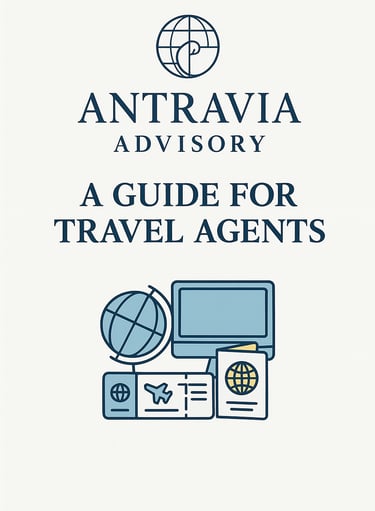
Travel Agent Finance Guide 2025: 5.3 U.S. and Global hotspots: Profitability by region
Part 5.3 of the Antravia Travel Agent Finance Guide - See how regional markets shape profitability for U.S. travel advisors. Explore Europe, Dubai, Africa, Asia, the Caribbean, Mexico, and South America, from commission levels to FX exposure and cash flow cycles, and learn how to balance short- and long-lead destinations for financial stability.
ANTRAVIA TRAVEL AGENT GUIDE
1/20/20258 min read


Part 5: Destinations and Market Positioning
In this part of our Travel Agent Finance Guide, we connect financial performance with the destinations you choose to sell. The mix of markets an advisor focuses on, whether luxury Europe, adventure Africa, emerging Asia, or ocean and river cruises, has direct implications for commission levels, supplier payment terms, and foreign exchange exposure.
Each market also comes with its own financial mechanics: currencies, settlement cycles, and credit practices that determine how quickly commissions convert into cash. Destination focus shapes not only margins but also liquidity, working capital needs, and forecasting patterns. A strong destination strategy balances high-margin opportunities with markets that provide stable demand and predictable cash flow.
This section will outline how destination mix influences profitability, why some regions carry higher risk or thinner margins, and how to balance your portfolio to protect both profit and cash. We will also link to our detailed Antravia Destination Series blogs, showing how financial insight can sharpen positioning and help you capture growth where demand is strongest. The aim is to show that destination selection is not just about marketing appeal but about building a financially balanced agency that can grow sustainably across economic cycles.
5.1 How Destination mix shapes Financial Results
Why destination mix impacts financial performance
FX exposure when selling international packages
Supplier payment structures in different regions
5.2 Cruises, River Cruises, and Niche Travel Models
Commission structures unique to cruises
Long lead times and deposit handling
River cruises as a growing segment
5.3 U.S. and Global Hotspots: Profitability by Region
Selling Dubai, Asia, Africa, and Europe
Regional risks and margin considerations
Aligning with U.S. traveler demand and spending trends
5.4 Cross-Linking to Antravia’s Destination Series
Connecting to Antravia’s detailed destination finance blogs
Using financial insight to sharpen positioning and market focus


Part 5.3 U.S. and Global hotspots: profitability by region
In Section 5.1, we examined how destination mix affects cash flow, margin, and FX exposure. This section looks at the same landscape through a market lens, so where U.S. traveler demand is strongest, how regional spending patterns are shifting, and what these trends mean for long-term profitability and positioning.
A well-balanced destination portfolio is good financial and sales strategy. Each region carries its own pattern of commissions, cash timing, and risk exposure. Understanding how markets like Dubai, Asia, Africa, and Europe etc behave financially allows travel advisors to align sales priorities with liquidity and profit stability.
This is a high level view of each region - For more details, look at our Antravia Destination Guides (below for links)
The U.S. outbound travel landscape
According to Brand USA and the National Travel and Tourism Office (NTTO), U.S. outbound travel exceeded 103 million international trips in 2024, up 19% from 2023, with spending topping $187 billion. The strongest outbound growth came from the Caribbean, Europe, and Asia, while demand for luxury experiential travel rose sharply.
Data from the USTOA 2024 Economic Impact Report show that nearly 80% of USTOA tour operators reported higher year-on-year sales, with Europe still dominating revenue but Africa, Asia, and the Middle East growing fastest. For advisors, this means the profitability landscape is shifting from traditional Europe-heavy portfolios to more diversified regional mixes.
Caribbean and Mexico - short cycle, consistent liquidity
The Caribbean and Mexico remain the most frequently booked regions for U.S. travelers, accounting for over 45 million outbound trips in 2024 (source: U.S. National Travel and Tourism Office). Average advisor commissions sit between 10 and 12 percent, with some hotel and resort programs offering higher incentives through preferred partnerships.
These markets have short booking cycles and fast payment timelines. Most suppliers pay commissions within 15 to 30 days of client departure, compared with 60–90 days in Europe or Africa. Packages sold through U.S.-based operators, such as Apple Vacations or ALG Vacations, are typically denominated in U.S. dollars, removing FX exposure and easing reconciliation.
Because travel to the Caribbean and Mexico peaks during U.S. winter months, these regions help offset cash slowdowns between the European summer and Q1 cruise season. For many agencies, Caribbean and Mexico sales serve as a liquidity anchor, i.e. a dependable stream of quick-turnover income that funds operations while longer-lead bookings mature.
Financially resilient agencies use these destinations as their “working capital stabilisers,” maintaining at least one-third of their annual revenue mix in short-cycle markets to keep cash flow balanced year-round.
South America - steady growth and stable FX
South America has quietly re-emerged as a profitable yet underexploited market for U.S. advisors. According to USTOA’s 2024 Economic Impact Report, Peru, Argentina, Chile, and Colombia are among the fastest-growing destinations for USTOA member operators. Average commissions range between 12 and 15 percent, often with stronger net pricing flexibility for small-group or FIT programs.
Many South American DMCs quote contracts in U.S. dollars, particularly for high-end and adventure travel, limiting FX exposure. However, local operators still tend to require 30–50 percent deposits and balance payments 60 days before travel, meaning cash management remains important.
Demand is shifting toward sustainable and experiential programs—such as Patagonia treks, culinary circuits, and cultural immersion tours—where margins are healthy and booking windows shorter than European programs. For U.S. agencies seeking diversification, South America offers mid-range lead times, moderate liquidity risk, and a growing volume of affluent U.S. travellers seeking off-season options.
Europe - high volume, tightening margins
Europe remains the cornerstone of U.S. outbound travel. It represents nearly 40% of all U.S. international departures, according to NTTO. Average advisor commissions on escorted or FIT land programs typically range between 10 and 15 percent, based on supplier structures from Trafalgar, Globus, and Insight Vacations.
However, margins are tightening. Inflation, higher operating costs for European suppliers, and dynamic pricing systems have reduced net margins for U.S. agents. Additionally, most European DMCs and tour operators require deposits and full payment 60–90 days before travel, which creates cash strain if client deposits aren’t collected early.
Currency exposure adds another layer of complexity. Although the euro–dollar rate has stabilised around 1.08–1.10 in 2025, even a small 3–5 percent fluctuation can materially affect gross margin on large programs. Advisors managing high European volume should forecast in euros and use consistent client deposit schedules to protect liquidity.
Dubai and the Middle East - high-margin luxury, supplier dependency
Dubai’s tourism market continues to perform strongly. Dubai’s Department of Economy and Tourism reported 9.88 million international visitors in the first half of 2025, a 6 percent year-on-year increase. Commissions on Dubai hotel and DMC bookings often range between 10 and 20 percent, with incentives for luxury properties and preferred partners.
From a financial perspective, Dubai offers strong per-booking revenue but significant supplier dependency. Local DMCs often require 100% prepayment and invoices are issued in dirhams (AED), creating FX exposure for U.S. advisors. Furthermore, hotel commissions can take 30–60 days to clear through global payment systems such as Onyx CenterSource or TACS.
Advisors selling Dubai should forecast on a net-cash basis (recognising funds only when received) and maintain supplier vetting to reduce insolvency risk, especially when routing payments through intermediaries.
Africa – rising demand, long cash cycles
Africa remains one of the most promising yet operationally demanding regions. USTOA data show Africa as the top “emerging destination” for 2025, led by South Africa, Kenya, Tanzania, and Egypt. Average commissions are among the highest in travel — typically 15 percent or more on safaris and private tours — but working capital exposure is significant.
Many safari operators and lodges require full prepayment 60–90 days before travel, while cancellations and refund delays are common. Currency volatility adds risk: the South African rand has seen 8–12 percent annual swings against the U.S. dollar since 2020 (source: Federal Reserve H10 FX data).
Agencies selling Africa profit most when they align client deposits directly with supplier due dates and quote in supplier currency or apply an FX buffer. Maintaining a reserve for refund contingencies protects cash flow from sudden cancellations.
Asia – flexible terms, variable margins
Asia’s recovery has been one of the most important global trends. The Pacific Asia Travel Association (PATA) reports that international arrivals to Asia-Pacific reached 88% of 2019 levels by mid-2025. For U.S. agents, Asia combines moderate margins (typically 10–12 percent) with more flexible supplier terms. Many inbound DMCs in Vietnam, Thailand, and Indonesia accept deposits of 20–30 percent and final balances 30–45 days before travel, allowing for shorter cash cycles than Europe or Africa.
However, FX exposure is more fragmented. Multiple currencies (baht, yen, rupiah) require dynamic pricing tools or USD-quoted contracts. Advisors focusing on Asia should build currency margins into quotes and plan for regional seasonality: winter demand spikes for Southeast Asia often offset Europe’s low season, smoothing annual revenue.
Aligning destination strategy with U.S. traveler trends
The U.S. Travel Association’s 2025 forecast highlights continued demand for luxury, experiential, and sustainable travel. Younger clients show willingness to pay for personalised, high-service itineraries, while older demographics still dominate cruise and escorted tour bookings.
For advisors, aligning financial performance with traveler trends means balancing high-margin, long-lead destinations (Europe, Africa, cruises) with shorter-cycle regions (Caribbean, Mexico, Asia) to manage liquidity. Agencies that map profitability by region and season like integrating commission data, deposit timing, and FX sensitivity, gain a more predictable annual cash flow.
Example – regional balance strategy
A U.S. agency found that 70% of its revenue came from Europe, creating a heavy summer peak and liquidity pressure each spring. By adding winter Asia programs and a small portfolio of Africa safaris, it reduced seasonality, lifted annual profit by 14 percent, and cut cash shortfall months from four to one.
Conclusion
Profitability is not determined by sales and shaped by where you sell. Each region brings different margins, deposit rules, and FX dynamics. U.S. agencies that track these patterns, forecast cash cycles by destination, and adapt to changing traveler demand can maintain both growth and stability across global markets.


References for Part 5.3 U.S. and Global hotspots: Profitability by region
Brand USA – U.S. International Travel Statistics 2025
https://www.thebrandusa.com/researchU.S. National Travel and Tourism Office (NTTO) – Outbound Travel Statistics
https://www.trade.gov/national-travel-and-tourism-officeU.S. Tour Operators Association (USTOA) – Economic Impact Report 2024
https://ustoa.com/press-releases/annual-economic-impactDubai Department of Economy and Tourism (DET) – Tourism Performance H1 2025
https://www.dubaitourism.gov.ae/Pacific Asia Travel Association (PATA) – Visitor Forecasts 2025
https://pata.org/Federal Reserve H10 – Foreign Exchange Rates
https://www.federalreserve.gov/releases/h10/currentWorld Travel and Tourism Council (WTTC) – Economic Impact 2024
https://wttc.org/research/economic-impactU.S. Travel Association – Industry Forecast 2025
https://www.ustravel.org/ALG Vacations – Partner terms and commission structure
https://www.algvacations.com/Federal Reserve H10 – Foreign Exchange Rates
https://www.federalreserve.gov/releases/h10/current


Acknowledgements
Antravia would like to thank our consulting clients and industry partners who generously shared their time, insights, and real-world case studies. All client examples have been anonymized and edited for clarity, but they are based on true advisory engagements and reflect real decisions, challenges, and financial outcomes from across the travel industry.


Antravia Advisory
Where Travel Meets Smart Finance
Email:
Contact us:
Antravia LLC
© 2025. All rights reserved. | Disclaimer | Privacy Policy | Terms of Use | Accessibility Statement
Antravia.com - Global site of the Antravia Group.
Antravia.com | Antravia.co.uk | Antravia.ae |
Finance.travel | Tax.travel | Consultancy.travel | Vat.travel | Vat.claims |
USSales.tax | EuroVAT.tax | UKVAT.tax |
contact@antravia.com
Antravia LLC
4539 N 22nd St., Ste. N
Phoenix
Arizona
85016
